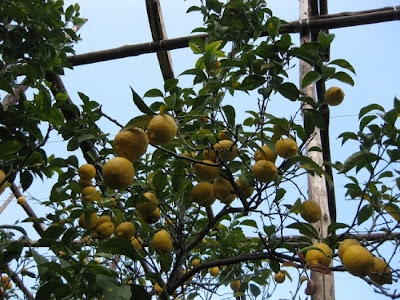 |
| Sorrento lemons |
The introduction of the varieties of lemons grown on the Amalfi Coast and the coastline surrounding Sorrento date back to Roman times, and have changed very little over the passing 2 millennia .
In fact, mosaics and paintings that survived in ancient Roman villas in Pompeii and Herculaneum show lemons that are shaped remarkably like those grown in Sorrento today.
 |
| Sorrento lemons |
Cultivated under traditional, tall wooden frames, these lemon groves require protection from cold winter winds, rain, hail and - rather surprisingly, the occasional frost.
And when I say tall I mean it, you can be looking at frames of up to 5 even 6 metres tall.
Why? Because the lemon varieties grow in Sorrento can get as tall as 8 metres. They are easy to spot as they are often left to protrude through the netting and have their fruit unharvested.
The tops and sides of the wooden structures were traditionally covered with a kind of rush, twig or bamboo matting - something that you can still see. However, growers are now starting to modernise and converting over to black plastic shading
 |
| Sorrento lemons |
Found in Campania region of southern Italy, sorrento lemons - otherwise known as the Limone di Sorrento, Ovale di Sorrento, Massese or Massa Lubrense lemon, is a highly regarded lemon variety whose popularity outside of the United States rivals that of the Eureka.
Even as late as the turn of the twentieth century, Sorrento lemons were sold individually and could only be handled by women who had to have trimmed nails and wear cotton gloves to handle them. Why? Well, the rind of the Sorrento lemon is relatively fragile and any damage to it will quickly allow fungal rots to take hold.
 |
| Me purchasing private supplies of limoncello |
The pulp is translucent yellow in colour and yields a large quantity of semi acidic juice. Although the flesh is very low in seeds and often found to be seedless, the lemon cannot be sold as a seedless variety.
In Italy the Sorrento lemon is the lemon used in the making of the popular and very tasty Italian liqueur, Limoncello. In fact 60% of the lemons cultivated are reserved for Limoncello. It is also the most widely used lemon for fresh consumption in Italy.
In November of 2000 Sorrento lemons earned their own IGP recognition (Protected Geographical Indication), similar to the prestigious AOC designation for cheeses.
For related article click onto:
AT WHAT TEMPERATURE DO CITRUS SEEDS GERMINATE AT?
DOES THE BUDDHA'S HAND CITRUS HAVE SEEDS?
How to get rid of black mould on a lemon tree
How to get rid of black mould on a lemon tree
HOW LONG DOES IT TAKE TO GROW A LEMON TREE FROM SEED?
HOW TO GROW A LEMON TREE FROM CUTTINGS
How to Grow a Lemon Tree from Seed
HOW TO GROW MANDARIN ORANGE FROM SEED - Citrus reticulata
HOW TO GROW A LEMON TREE FROM CUTTINGS
How to Grow a Lemon Tree from Seed
HOW TO GROW MANDARIN ORANGE FROM SEED - Citrus reticulata
HOW TO GROW THE POMELO - Citrus grandis FROM SEED?
How to make Limoncello
Sorrento Lemons
THE CITRON - Citrus medica
The Secret to Growing Giant Lemons
Why are the Leaves on my Lemon Tree Turning Yellow?
WHY ARE MY LEMON LEAVES CURLING?
Why is there Black Mould on my Lemon Tree?
Why is my Lemon Tree Dropping Leaves?
Why are the Leaves on my Lemon Tree Sticky?
WHY IS THERE BLACK MOULD ON MY LEMON TREE?
How to make Limoncello
Sorrento Lemons
THE CITRON - Citrus medica
The Secret to Growing Giant Lemons
Why are the Leaves on my Lemon Tree Turning Yellow?
WHY ARE MY LEMON LEAVES CURLING?
Why is there Black Mould on my Lemon Tree?
Why is my Lemon Tree Dropping Leaves?
Why are the Leaves on my Lemon Tree Sticky?
WHY IS THERE BLACK MOULD ON MY LEMON TREE?







No comments:
Post a Comment